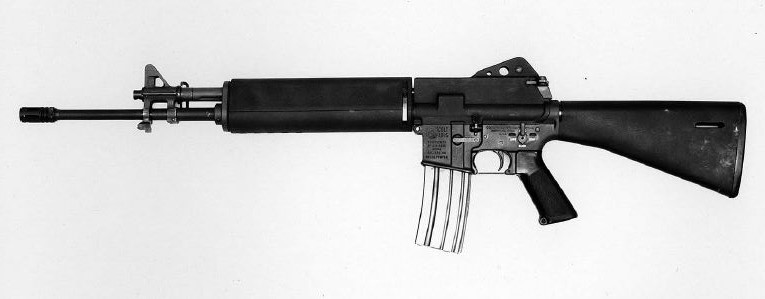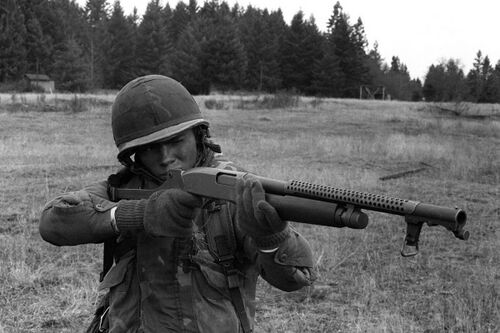Do you guys remember that era when piston-driven AR-15s promised to be the next big thing? People were still hooting and hollering about how unreliable ARs were, and the AWB had only recently sunset. So, cultural knowledge of the gun wasn’t nearly as high as it is now. Piston-driven ARs would provide AK-like reliability with AR ergonomics and accuracy!
Most of those designs promptly went nowhere, and a few holdouts still produce piston-driven ARs. However, the piston-driven AR wasn’t just a phenom of the early to mid-2000s. It dates back to 1969 with a gun called the Colt 703.
The AR-15 and later M16’s reputation for poor reliability all come from Vietnam. Whether or not it was purposeful sabotage or government ineptness is up for debate, but the M16 got a helluva start. The rifle was issued without cleaning kits, and soldiers were told it didn’t need to be cleaned. The gun was firing ammo that used the wrong type of propellant, which increased fouling. Oh, and it lacked a chrome chamber, which is great for Vietnam.
Advertisement — Continue Reading Below

The initial failure of the M16 tainted the gun decades later. The immediate aftermath was an investigation by the House Armed Services Committee. This resulted in the Report of the M16 Rifle Review Panel. The report wasn’t kind to the M16 and identified perceived weaknesses of the design. Eugene Stoner and Armalite may have designed the rifle, but Colt was producing it for the Army, and this report got their hands sweaty. They went about producing a replacement for the M16 and called it the Colt 703.
The Colt 703 – What’s In a Name?
Colt had an inconsistent naming arrangement regarding the Colt 703 series. There are two Colt 703s. One is a standard AR-15-style rifle that lacks a long-stroke gas piston system, and the other is this gun. Colt also called the piston-driven 703 the M16A2. That was a tad presumptuous, and the gun clearly has nothing to do with the actual M16A2 adopted well after Vietnam.
Advertisement — Continue Reading Below
Breaking Down the Colt 703
The AR-15 uses a direct-impingement gas system, which has been disliked since its inception. The gun does blow more carbon into the receiver, but if the proper propellant had been used, this wouldn’t have been a major problem, and with proper ammo and a cleaning kit, it’s not a problem at all.
Colt recognized that if they were stuck with the Olin WC 846 ball powder, they’d have to move to another system. The long-stroke gas piston system had already been well-proven to work. The long-stroke system of the AK worked quite well, even with Soviet ammo. Colt decided to implement this system into the M16 design.

Advertisement — Continue Reading Below
This called for a new upper receiver design. Colt kept a lot of M16 components, including the barrel and sight system. The gun required an AK-like gas key tube that sits above the barrel. This creates a larger upper receiver that’s taller. The top portion of the upper receiver sits well above the stock, unlike the inline design of the M16. The Colt 703 utilized the M16-style charging handle, the bolt, and the bolt carrier group. Colt used a different handguard attachment system due to the change in the upper receiver design.
It was tall enough that Colt eliminated the carry handle design. Instead, we had a more standard-looking rear sight design. Colt stuck with the M16’s lower receiver and stock layout. The stock did feature a trapdoor cleaning kit that would be preserved in further M16 rifles.
Clever Design
Colt was clever with the 703. At first glance, it looks radically different from the M16. In reality, it’s more of a Clark Kent/Superman-style disguise. It looks different, but with a close look, it’s pretty close in design to an M16. They clearly designed the gun to mimic the adopted rifle to simplify logistics for everyone. This resulted in a radical change to the upper and handguards, but once you get past that, it’s all M16.
Advertisement — Continue Reading Below
If you had to replace the M16 early in its development, this wouldn’t have been tough to do. The Colt 703 could still likely be produced quickly to replace the M16 without much difficulty. The Colt 703 did weigh 8.7 pounds, which is a pound heavier than the M16. Colt never mass-produced the gun.

The Army issued cleaning kits and comic book-style manuals for the M16. They kept the ball powder for a little longer than necessary, but cleaning kits and chrome chambers drastically increased rifle reliability. Eventually, the ball powder was swapped for stick powder, and the M16 and M4 carbine variants still serve to this day.
Advertisement — Continue Reading Below
The Colt 703 was a novel take on the M16, but it never got off the ground. It does prove that everything old is new again, and you can find much more refined piston-driven ARs from companies like PWS. It’s unfortunate that the Colt 703 never took off, and we might’ve solved the piston-driven AR-15 argument a bit earlier.















